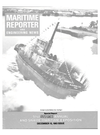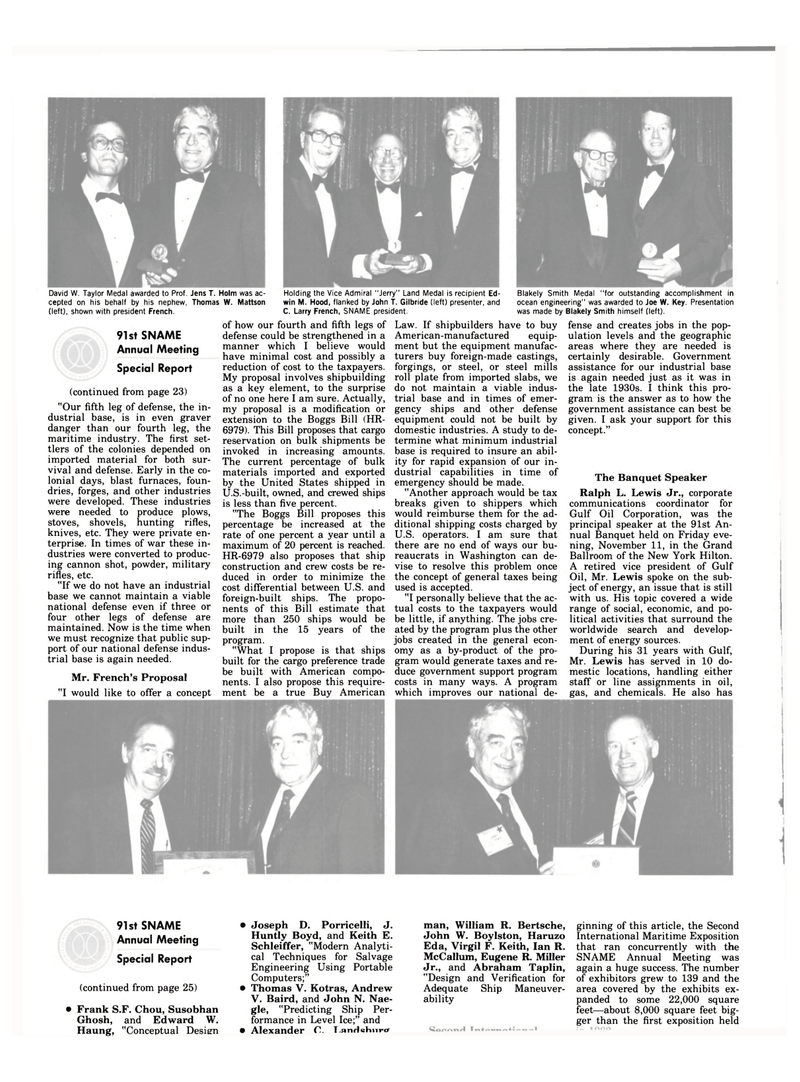
Page 22: of Maritime Reporter Magazine (December 15, 1983)
Read this page in Pdf, Flash or Html5 edition of December 15, 1983 Maritime Reporter Magazine
David W. Taylor Medal awarded to Prof. Jens T. Holm was ac- cepted on his behalf by his nephew, Thomas W. Mattson (left), shown with president French.
Holding the Vice Admiral "Jerry" Land Medal is recipient Ed- win M. Hood, flanked by John T. Gilbride (left) presenter, and
C. Larry French, SNAME president.
Blakely Smith Medal "for outstanding accomplishment in ocean engineering" was awarded to Joe W. Key. Presentation was made by Blakely Smith himself (left). 91st SNAME
Annual Meeting
Special Report (continued from page 23) "Our fifth leg of defense, the in- dustrial base, is in even graver danger than our fourth leg, the maritime industry. The first set- tlers of the colonies depended on imported material for both sur- vival and defense. Early in the co- lonial days, blast furnaces, foun- dries, forges, and other industries were developed. These industries were needed to produce plows, stoves, shovels, hunting rifles, knives, etc. They were private en- terprise. In times of war these in- dustries were converted to produc- ing cannon shot, powder, military rifles, etc. "If we do not have an industrial base we cannot maintain a viable national defense even if three or four other legs of defense are maintained. Now is the time when we must recognize that public sup- port of our national defense indus- trial base is again needed.
Mr. French's Proposal "I would like to offer a concept of how our fourth and fifth legs of defense could be strengthened in a manner which I believe would have minimal cost and possibly a reduction of cost to the taxpayers.
My proposal involves shipbuilding as a key element, to the surprise of no one here I am sure. Actually, my proposal is a modification or extension to the Boggs Bill (HR- 6979). This Bill proposes that cargo reservation on bulk shipments be invoked in increasing amounts.
The current percentage of bulk materials imported and exported by the United States shipped in
U.S.-built, owned, and crewed ships is less than five percent. "The Boggs Bill proposes this percentage be increased at the rate of one percent a year until a maximum of 20 percent is reached.
HR-6979 also proposes that ship construction and crew costs be re- duced in order to minimize the cost differential between U.S. and foreign-built ships. The propo- nents of this Bill estimate that more than 250 ships would be built in the 15 years of the program. "What I propose is that ships built for the cargo preference trade be built with American compo- nents. I also propose this require- ment be a true Buy American
Law. If shipbuilders have to buy
American-manufactured equip- ment but the equipment manufac- turers buy foreign-made castings, forgings, or steel, or steel mills roll plate from imported slabs, we do not maintain a viable indus- trial base and in times of emer- gency ships and other defense equipment could not be built by domestic industries. A study to de- termine what minimum industrial base is required to insure an abil- ity for rapid expansion of our in- dustrial capabilities in time of emergency should be made. "Another approach would be tax breaks given to shippers which would reimburse them for the ad- ditional shipping costs charged by
U.S. operators. I am sure that there are no end of ways our bu- reaucrats in Washington can de- vise to resolve this problem once the concept of general taxes being used is accepted. "I personally believe that the ac- tual costs to the taxpayers would be little, if anything. The jobs cre- ated by the program plus the other jobs created in the general econ- omy as a by-product of the pro- gram would generate taxes and re- duce government support program costs in many ways. A program which improves our national de- fense and creates jobs in the pop- ulation levels and the geographic areas where they are needed is certainly desirable. Government assistance for our industrial base is again needed just as it was in the late 1930s. I think this pro- gram is the answer as to how the government assistance can best be given. I ask your support for this concept."
The Banquet Speaker
Ralph L. Lewis Jr., corporate communications coordinator for
Gulf Oil Corporation, was the principal speaker at the 91st An- nual Banquet held on Friday eve- ning, November 11, in the Grand
Ballroom of the New York Hilton.
A retired vice president of Gulf
Oil, Mr. Lewis spoke on the sub- ject of energy, an issue that is still with us. His topic covered a wide range of social, economic, and po- litical activities that surround the worldwide search and develop- ment of energy sources.
During his 31 years with Gulf,
Mr. Lewis has served in 10 do- mestic locations, handling either staff or line assignments in oil, gas, and chemicals. He also has 91st SNAME
Annual Meeting
Special Report (continued from page 25) • Frank S.F. Chou, Susobhan
Ghosh, and Edward W.
Haung, "Conceptual Desien • Joseph D. Porricelli, J.
Huntly Boyd, and Keith E.
Schleiffer, "Modern Analyti- cal Techniques for Salvage
Engineering Using Portable
Computers;" • Thomas V. Kotras, Andrew
V. Baird, and John N. Nae- gle, "Predicting Ship Per- formance in Level Ice;" and • Alexander fl. T.anrfshnro man, William R. Bertsche,
John W. Boylston, Haruzo
Eda, Virgil F. Keith, Ian R.
McCallum, Eugene R. Miller
Jr., and Abraham Taplin, "Design and Verification for
Adequate Ship Maneuver- ability ginning of this article, the Second
International Maritime Exposition that ran concurrently with the
SNAME Annual Meeting was again a huge success. The number of exhibitors grew to 139 and the area covered by the exhibits ex- panded to some 22,000 square feet—about 8,000 square feet big- ger than the first exposition held

 21
21

 23
23
